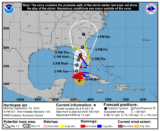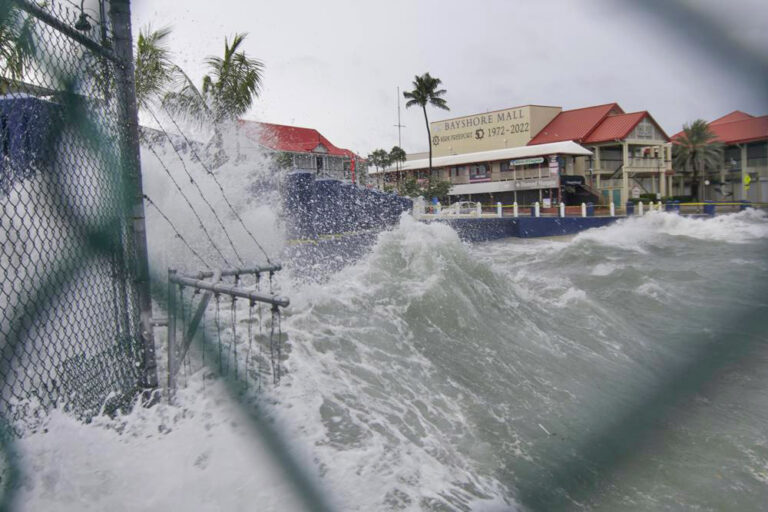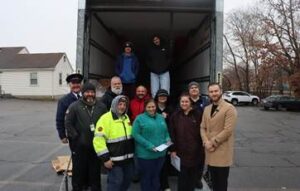HAVANA — Hurricane Ian was growing stronger as it barreled toward Cuba on a track to hit Florida’s west coast as a major hurricane as early as Wednesday.
Ian was forecast to hit the western tip of Cuba as a major hurricane and then become an even stronger Category 4 with top winds of 140 mph over warm Gulf of Mexico waters before striking Florida.
Truck drivers and others involved in freight movement and the logistics industry are already preparing, although it’s not yet clear exactly where the storm will make landfall.
“Right now, we just don’t know, but I’ve got a few rigs that run throughout Florida, so we are preparing to begin taking them off the roads as soon as forecasters tell u where the storm will hit,” said Jim Crume, who owns a small trucking company based in Tampa Bay. “If we need to, we can help haul water or other things after the storm is over. Wherever it hits is gonna need a lot of help.”
As of Monday, Tampa and St. Petersburg appeared to be the among the most likely targets for their first direct hit by a major hurricane since 1921.
“Please treat this storm seriously. It’s the real deal. This is not a drill,” Hillsborough County Emergency Management Director Timothy Dudley said at a news conference on storm preparations in Tampa.
Authorities in Cuba were evacuating 50,000 people in Pinar del Rio province, sent in medical and emergency personnel, and took steps to protect food and other crops in warehouses, according to state media.
“Cuba is expecting extreme hurricane-force winds, also life-threatening storm surge and heavy rainfall,” U.S. National Hurricane Center senior specialist Daniel Brown told The Associated Press.
The hurricane center predicted areas of Cuba’s western coast could see as much as 14 feet of storm surge Monday night or early Tuesday.
In Havana, fishermen were taking their boats out of the water along the famous Malecon, the seaside boardwalk, and city workers were unclogging storm drains ahead of the expected rain.
Havana resident Adyz Ladron, 35, said the potential for rising water from the storm worries him.
“I am very scared because my house gets completely flooded, with water up to here,” he said, pointing to his chest.
In Havana’s El Fanguito, a poor neighborhood near the Almendares River, residents were packing up what they could to leave their homes, many of which show damage from previous storms.
“I hope we escape this one because it would be the end of us. We already have so little,” health worker Abel Rodrigues, 54, said.
On Monday night, Ian was moving northwest at 13 mph, about 130 miles southeast of the western tip of Cuba, with top sustained winds increasing to 100 mph.
The center of the hurricane passed to the west of the Cayman Islands, but no major damage was reported there Monday, and residents were going back into the streets as the winds died down.
“We seem to have dodged the bullet” Grand Cayman resident Gary Hollins said. “I am a happy camper.”
Ian won’t linger over Cuba but will slow down over the Gulf of Mexico, growing wider and stronger, “which will have the potential to produce significant wind and storm surge impacts along the west coast of Florida,” the hurricane center said.
Back in Florida, driver Flo Sanders, who works regional routes along the Gulf Coast, said she is anxious over the storm. She’s only been driving big rigs for two years and is from Iowa.
“We don’t have anything like this up there,” she said. “I really don’t know what to expect. I am working off the advice of more experienced drivers. The best thing to do is just shut it down in the areas you know will be affected by the storm. I just hope no one gets caught off guard.”
A surge of up to 10 feet of ocean water and 10 inches of rain was predicted across the Tampa Bay area, with as much as 15 inches inches in isolated areas. That’s enough water to inundate coastal communities.
As many as 300,000 people may be evacuated from low-lying areas in Hillsborough County alone, county administrator Bonnie Wise said. Some of those evacuations were beginning Monday afternoon in the most vulnerable areas, with schools and other locations opening as shelters.
“We must do everything we can to protect our residents. Time is of the essence,” Wise said.
Floridians lined up for hours in Tampa to collect bags of sand and cleared store shelves of bottled water. Gov. Ron DeSantis declared a statewide emergency and warned that Ian could lash large areas of the state, knocking out power and interrupting fuel supplies as it swirls northward off the state’s Gulf Coast.
“You have a significant storm that may end up being a Category 4 hurricane,” DeSantis said at a news conference. “That’s going to cause a huge amount of storm surge. You’re going to have flood events. You’re going to have a lot of different impacts.”
DeSantis said the state has suspended tolls around the Tampa Bay area and mobilized 5,000 Florida state national guard troops, with another 2,000 on standby in neighboring states.
President Joe Biden also declared an emergency, authorizing the Department of Homeland Security and the Federal Emergency Management Agency to coordinate disaster relief and provide assistance to protect lives and property. The president postponed a scheduled Tuesday trip to Florida because of the storm.
The Tampa Bay Buccaneers announced Monday night that the football team was relocating football operations to the Miami area in preparation for next weekend’s game against the Kansas City Chiefs. The Buccaneers said the team will leave Tampa on Tuesday and relocate in Miami-Dade County. The Buccaneers are expected to practice at the Miami Dolphins’ training complex in Miami Gardens, Florida, starting on Wednesday and continue through this week’s preparations, if necessary.
Flash flooding was predicted for much of the Florida peninsula, and heavy rainfall was possible for the southeast United States later this week. With tropical storm force winds extending 115 miles from Ian’s center, watches covered the Florida Keys to Lake Okeechobee.
Bob Gualtieri, sheriff of Pinellas County, Florida, which includes St. Petersburg, said in a briefing that although no one will be forced to leave, mandatory evacuation orders are expected to begin Tuesday.
“What it means is, we’re not going to come help you. If you don’t do it, you’re on your own,” Gualtieri said.
Zones to be evacuated include all along Tampa Bay and the rivers that feed it. St. Petersburg Mayor Ken Welch urged residents not to ignore any evacuation orders.
“This is a very real threat that this storm poses to our community,” Welch said.
The hurricane center has advised Floridians to have survival plans in place and monitor updates of the storm’s evolving path.

Solera Fleet Solutions/Omnitracs offers the following hurricane safety tips for truck drivers:
Don’t forget to prepare for the before, during and after. Before a hurricane hits, there are various ways drivers can prepare themselves and their cabs for the storm. Drivers can — and should — prepare for the worst-case scenarios, including getting caught in the middle of the hurricane or its aftermath.
While it is always imperative that drivers aim to be off the road during a hurricane, they should get off the road as slowly and carefully as possible if they find themselves stuck in one. While driving during and after a hurricane, avoid driving through pools of water. Standing water can hide fallen power lines and sinkholes and may look far less deep than it is.
Get ahead of the weather and route. The National Weather Service will issue three different kinds of alerts with impending hurricanes. The first alert is an advisory, which signifies potentially hazardous, but mostly non-life-threatening inconveniences. The second alert is a watch, which indicates a potential tropical storm or hurricane within 48 hours. The third and most crucial alert is a warning signifying an impending tropical storm or hurricane within 36 hours.
If driving in areas that are potentially sensitive to hurricanes, drivers should look through their planned route before they go to stay in the know on how to prepare best. If driving through one of these areas, be sure to tune into the local weather radio station and continuously monitor weather updates.
Remember that safety and flexibility go hand in hand. Nothing is worth jeopardizing personal safety or the safety of others. The sheer weight and size of commercial motor vehicles, coupled with weather-related incidents, can result in massive disasters on the road.
Any reasonable customer or manager should and must understand that safety is the top priority while drivers are on the road, so keep a flexible mentality. Communicate delays to routes as needed; remember, slow and safe is better than fast and sorry.
Practice open communication. While experienced fleet managers and dispatchers prioritize driver safety, they’re not in the driver’s seat. Drivers should keep the lines of communication with them open, so they know what drivers see when they see it.
Open communication also helps back-office teams reroute drivers as needed, so they can further avoid dangerous routes altogether.
Equip the truck with the right necessities. Drivers should ensure their cab is fully stocked with the proper necessities on the road.
Here are the vital supplies drivers will want to keep on hand:
- Bottled water and non-perishable food.
- Rain gear, such as umbrellas, ponchos, and boots.
- A pack of different types of batteries.
- A flashlight or headlamp.
- A portable phone charger.
- Protective cold-weather gear, including gloves, warm clothing, and blankets.
Other hurricane safety tips and resources are available from the National Weather Service.
Meanwhile, the American Logistics Aid Network is urging Florida and Gulf Coast residents to prepare — and asking members of the logistics community who aren’t located near the storm’s path to be ready to help.
“Over the next few days Hurricane Ian has the potential to deliver high winds, strong rains and a significant storm surge across many parts of Florida,” Kathy Fulton, ALAN’s executive director, said. “We are mobilizing accordingly.”
Late last week, ALAN began what Fulton calls the preparedness stage of the disaster relief organization’s storm activation, which includes:
- Providing pre-storm information about the storm’s latest path and supply chain impacts via its Supply Chain Intelligence Center, which can be accessed for free at www.alanaid.org/map.
- Updating ALAN’s Disaster Micro-site with helpful links for those who are in Hurricane Ian’s cone of concern. That site is also where ALAN will share any specific requests for logistics assistance that it receives because of the storm.
- Checking in with members of the nonprofit and disaster relief community to find out what resources they anticipate needing.
- Working closely with government and industry officials to share critical disaster and supply chain information.
ALAN’s response relief efforts — which include fielding and filling specific requests for logistics help — will commence later this week if the storm’s strength and path continue as predicted.
“Most of our requests for assistance arrive after a hurricane or tropical storm has hit,” Fulton said. “That’s because each storm winds up having very different outcomes and pain points. And you really can’t predict what those will be – and where relief organizations will require supply chain assistance the most – until after the storm has moved through.”
As always, Fulton said that ALAN hopes these measures will prove to be merely precautionary.
“Over the years we’ve seen some potentially catastrophic hurricanes that have turned into relatively minor events while others have morphed into far more deadly and destructive events than expected,” she said. “We are praying that Hurricane Ian will turn out to be the former. However, if it isn’t, we want people to remember that ALAN is here to help – and to do everything in their power to keep themselves and their loved ones safe.”
The Associated Press contributed to this report.
The Trucker News Staff produces engaging content for not only TheTrucker.com, but also The Trucker Newspaper, which has been serving the trucking industry for more than 30 years. With a focus on drivers, the Trucker News Staff aims to provide relevant, objective content pertaining to the trucking segment of the transportation industry. The Trucker News Staff is based in Little Rock, Arkansas.















